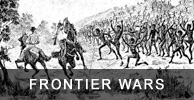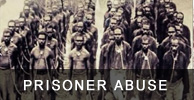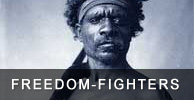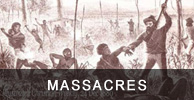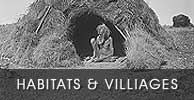The Rufus River Massacre - Lake Victoria South West NSW
'The Rufus River Massacre'
Pat and Brian Glenie Renmark/Paringa/Cal Lal Historical and Preservation Society Inc
Compiled by Peter J Reilly 1998/99 - some editing by Sovereign Union 2008, 2017
This is from the invaders records of events, we don't have a written Aboriginal record of events.
The 'Troublesome' Blacks
February 1840; - The Commissioner of Police South Australia, seeks to have Police Stations established at Morphett's Ferry (Wellington) and at North-West Bend (Morgan), for the intervention and prevention of clashes between Overlanders and Aborigines
Throughout 1840 and into 1841 'troublesome skirmishes' persist. Then, in April 1841, the Europeans suffer their first serious losses.
April 16, 1841; When in 'The Islands Country', that region adjacent to the Murray in the New South Wales/South Australia border section wherein a labyrinth of creeks and branches create a multiplicity of islands, the party of Mr Inman and Mr Henry Field, with around 4-5,000 sheep, is set upon by 300 to 400 marauding blacks, who plunder the sheep and drays. The Europeans report at least one Aborigine was slain and several Europeans wounded, with some reports claiming that one European was killed. All except the possibility of one European returned to Adelaide alive.
On Governor Gawler's orders. Major O'Halloran leads a Police troupe from Adelaide numbering 23 mounted men, plus drays and drivers, to recover the plundered sheep and drays. - On April 30th, however, when the troupe is still 50-miles short of the attack site, they are recalled by dispatch rider. O'Halloran is perplexed by the recall as his journal entry indicates; viz- "I have no alternative, as an old soldier, than to obey His Excellency's orders, who, of course, has his own just reasons for ordering me back, and which it is my duty not to question, but to obey."
On his return to Adelaide, however, 'the reasons' become apparent. Governor Gawler's term of office has lately expired and one Captain George Grey, is now the new Governor of South Australia.
The Colonial Retreat
On hearing of the recall, the brother of Henry Field, Lieutenant W. G. Field, heads-up a party of 10 mounted volunteers in an attempt to recovery the plundered property. They departed Adelaide on 7th May and, perchance, increase their numbers en-route. For it is elsewhere recorded that on May 13th, as "the small group of fourteen Europeans" neared the attack site, they are confronted by 300 Aborigines.
The Europeans form a line and ride at the Aborigines who hold their ground and begin throwing spears. The Europeans are forced to retreat and the Aborigines pursue them for some distance.
In a report he later submitted to Governor Grey. - Lieutenant Field states, -'The first man to throw a spear, I shot through the head and gave the order to fire, hoping that when they saw two or three fall they would have retreated. But they did not appear in the slightest degree intimidated, but still advanced in the form of a crescent, in a body of at least 200, while many more were partially seen in the thick part of the scrub. The affray had now lasted more than half an hour, and I directed the party to retreat in order. - There were few shots fired without effect, and the last man shot was one of their chiefs. I feel convinced that the sheep remaining are not far distant, and the natives had assembled for the purpose of defending them.'
A statement was also given by volunteer John Allen, to the Commissioner of Police of South Australia; it read in part, - 'To the best of my belief, 8 natives were killed and several wounded during the contest, which lasted upward of half an hour. On the side of the volunteers, one horse was killed and two wounded, likewise Lt Field. It was apparent to all the party that the natives had no fear of the firearms, they were determined to obstruct our passage at whatever loss to themselves. Therefore, and finding it impossible to proceed, it was determined to retreat; the natives continued to follow the party for some distance.'
The volunteers defeat causes a bit of a furore in Adelaide. Meetings were held and resolutions to petition the Governor, 'For police to safeguard the vital links between the Colonies"; and "to protect Overlanders' rights and property, etc etc' - were very popular.
Governor refuses settler protection
Governor Grey's response, however, fell well short of the Settler's expectations. - In part it read, 'The resources of the Local Government would never suffice to afford protection for all parties who might desire it and if proprietors, for the sake of gain, will venture with their flocks and herds so far beyond the limits of the settled districts, they voluntarily encounter a risk from which they are bound to protect themselves.'
Even Charles Sturt offered to help. He wrote to Governor Grey on May 29 citing his credentials as, 'The discoverer of the Murray', the first to communicate with the Murray natives, 20 years of military service, being a Magistrate of both South Australia and New South Wales, and that his presence would be highly approved by the Colonial Office. He proposed that disciplined firmness was required to cope with the natives and that a disorganised attack of horsemen would fail ... Furthermore, he remarked, - " It may be that the hostility of the natives has been roused by accidental, perhaps hasty, collision with some of the overland parties; and how, by a show of firmness and forbearance, they may be controlled, if not pacified, until such time as the parties with stock, so rapidly approaching the neighbourhood of the assembled tribes, shall have been rescued from danger. ... a gun is a poor weapon of defence when once discharged ... of this, the natives appear to be aware. The bayonet therefore, is absolutely necessary to meet their rush, but even with a bayonet a single individual can affect but little. It is only by mutual support that attacks are to be successfully repelled."
But Governor Grey had already done an 'about-face'. For on May 31st, 1841; -the Commissioner of Police South Australia, Major Thomas O'Halloran, and the Protector of Aborigines, Dr Matthew Moorhouse, under Grey's instructions, departed Adelaide with a troupe of police plus volunteers, bullock drivers and cooks, totalling 68 persons; charged with recovering livestock, stolen from the Overlanders.
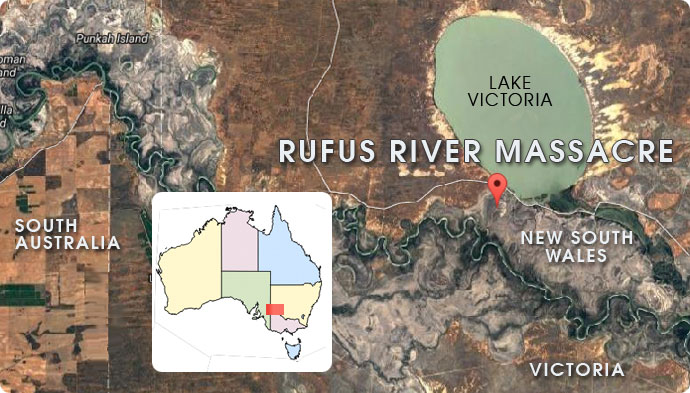 Rufus River Massacre - 26th and 27th August 1841
Rufus River Massacre - 26th and 27th August 1841NOTE: The background map is how the area looks now, via Google Maps.
The first police expedition
From the journal of Major T O'Halloran, - May 31, 1841; at ten past eleven o'clock, we commenced our march accompanied by the Protector of Aborigines, Dr Moorhouse. The foot police, with the drays and the foot volunteers, left town in advance of us on Saturday 29th instant, with six weeks provisions for the entire force; ... Major O'Halloran was ex-army, he regularly drilled the men in sword fighting and firing from horseback. He marched the troupe in fighting order, with advance and rear guards, with the carts and drays in the centre.
Dr Moorhouse was later to report - June 22nd; at 12 o'clock the drays halted and tents were pitched for the night. At 1 o'clock the mounted party continued their march and, at half-past two, met Mr Langhorne's party. Their condition excited the commiserations of all present. Their dray was in advance; the bullock driver was nearly naked. On the front of the dray sat a stockkeeper who had been speared in the leg and in the body of the dray was lying Mr Miller, the overseer, in a state of intense suffering from spear wounds in different parts of his body. They expressed their delight at seeing us, especially as their number had been reduced by four, out of sixteen, and their firearms in bad condition.
Back at camp, Commissioner O'Halloran sought statements from both Miller and Langhorne; -
Miller's account read in part - On Sunday 20th at about half-past eleven o'clock, when nine men and myself had just crossed our provisions and drays over the Rufus. We were surrounded by a party of about 500 natives, and, when reloading the drays, the blacks rushed towards us and commenced throwing waddies. We had only six muskets with us, and two of them would not go off. The natives soon began to draw spears and we commenced firing amongst them. The fight lasted about twenty minutes, and the result was the death of four of our party, and five blacks.
Langhorne's version was a bit more verbose - Camp June 22 1841; It is my painful duty to inform you that my party was attacked on their overland route to Adelaide with cattle on our arrival at Rufus Creek, near Lake Victoria, about 15 miles from where we are at present encamped. I was not present at the time of the attack. But from information I have received on my joining the party, I consider the number of blacks was from 500 to 600.
The scene I witnessed on joining the camp was most appalling. Four men were laying on the opposite bank most brutally murdered. One had received 20 spears in different parts of his body, and another with his belly ripped open and his entrails torn out. On reaching those of my party that were spared, I found Mr Miller had received seven spear wounds, and another man was speared in the leg and unable to walk. The cattle were scattered over the bush. We immediately crossed what cattle we were able to collect and returned to the camp to gather what supplies they had left. For they had emptied the bags of flour on the ground, also tea, tobacco, etc., bedding clothing and cooking utensils they took with them, leaving us destitute of everything with the exception of the clothes we were wearing.
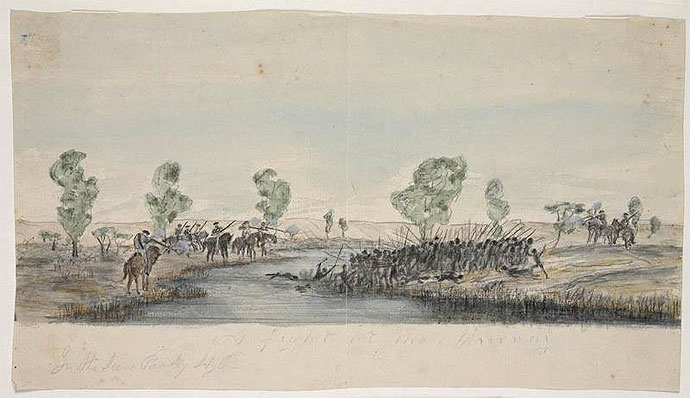 Rufus River Massacre - 26th and 27th August 1841
Rufus River Massacre - 26th and 27th August 1841
We fortunately recovered some of the working bullocks and proceeded on our journey, when we providentially met with you, Sir, all of us being in a state of exhaustion and in dread of being murdered. ... I beg to add, that another party under Mr Robinson, with 7,000 sheep, ought to be here in about 3 or 4 weeks, and unless steps are taken by Government for their preservation I feel perfectly certain that the whole party will be murdered, for the overland route is now completely closed and this fierce tribe will doubtless become more daring in consequence of having now defeated three successive parties. And as sheep are more valued by them than cattle, Mr Robinson's party have not a chance to escape, unless their countrymen take immediate and active steps for their rescue. ... Chas Langhorne;
This attack took place, on the Rufus, midway between Lake Victoria and The Murray, and, as a result, the site became known as 'Langhorne Ferry'. Overlanders were at their most vulnerable when crossing rivers and creeks, their numbers being necessarily divided on opposite banks.
O'Halloran's journal records the events that:
- June 23, 1841 - Fortified our camp, which I left with 17 men under command of Captain Ferguson, and with 41 mounted men and 14 foot, proceeded to scour the creeks and country around to the southward of our camp in search of Inman's sheep. Beat through the very heart of the hostile blacks' country where their huts, whurleys and other encampments were very numerous, as also the places where they had folded the sheep. The carcasses of the later were countless and lay strewed about for miles in all directions, in heaps, and apparently as if they had all been killed at the same time. We also came to a grave, recently formed, and very tastefully covered with boughs, in the shape of a dome, where many blacks were buried. - A little before dark we got back to camp after a hard day's work for man and horse, and much disheartened to find that all Mr Inman's sheep are gone, and that no prisoners were taken.
- June 24, 1841 - Mr. Langhorne requested my assistance in recovering 70 head of cattle on the Rufus, taken from him by natives. - Were unable to make the River Rufus till half-past 3pm., when we discovered to our horror, that one of the four Europeans (Mr Martin) lately murdered, and all of whom had been placed in the river by their comrades, had again been hauled out of the water, his thigh bone taken out and a green bough placed in his hand.
- June 25, 1841 - With drays we marched for the Rufus at 20 past 8, and got to the place where the party were attacked and which I shall call 'Langhorne Ferry'. - On my side of the Rufus, a scout notified that 30 blacks were going along the lake, we dashed on in pursuit, waded over to the New South Wales side at the junction of the Rufus with Lake Victoria, and pushed along the banks of the latter at a rapid pace. To our regret we found the natives had got to the other side of the lake, where they soon disappeared, and close to them we saw no less than 8 canoes. On arriving at the ferry, we lit a large fire over poor Mr Martin's grave, in hope that the blacks might not recognise it, and blazed some trees near the river and cut largely and deeply upon them 'BEWARE OF BLACKS', to warn the next unhappy overlanders of their danger.
So ended the first official retaliatory expedition directed against the Aborigines of the Rufus River district. - The 'problem' remained unresolved, however. - For the Governor of New South Wales had, by now, officially requested South Australia's assistance in protecting the Overlanders and their property.
- As it was already known that Mr Robinson's overland party would shortly be in the area, the Governor of S. A. directed that a relief party be sent to the region of the Rufus, rendezvous with the Overlanders and accompany them back to Adelaide. - The Governor's expressed intention was clear, the relief party was to provide protection for the Overlanders by a show of manpower and thereby circumvent further confrontation. - Confrontation was to be an absolute last resort.
... Aboriginal Australians had developed an extraordinarily high level of empathy towards the environmentally fragile nature of the land in which they lived. – In hindsight, it becomes clear that, in spite of possessing an abundance of magical items such as horses, drays, axes, blankets, tea, sugar, flour and firearm. In terms of Aboriginal wisdom, these 'New Arrivals' with their obscene numbers of alien livestock, were treating this land as would a tribe of fools.
The Rufus River Massacre
The relief party departed Adelaide on July 31, 1841; - it comprised Sub-Inspector Shaw, Sergeant Williams and ten Police on foot, plus volunteers. - John Ellis provisioned the entire party. - Governor Grey supplied arms and loaned the use of government bullocks, drays, tarpaulins and cooking utensils.
Shaw was in charge of the police plus the volunteers and the government equipment. - The Protector of Aborigines, Dr Matthew Moorhouse, was in overall charge of the troupe, which totalled 29 Europeans and 3 Aborigines. - They carried 2 months rations, for it was expected to make only 10 miles a day in the heavy winter conditions. Moorhouse, being mounted, delayed his departure and caught up with the troupe on August 4th.
Robinson had departed Gundagai for Adelaide on July 1, 1841: - He'd been made aware of the attacks on the Europeans and was accompanied by 25 well armed men to protect 6,000 sheep, 500 mixed cattle, plus horses and 3 drays.
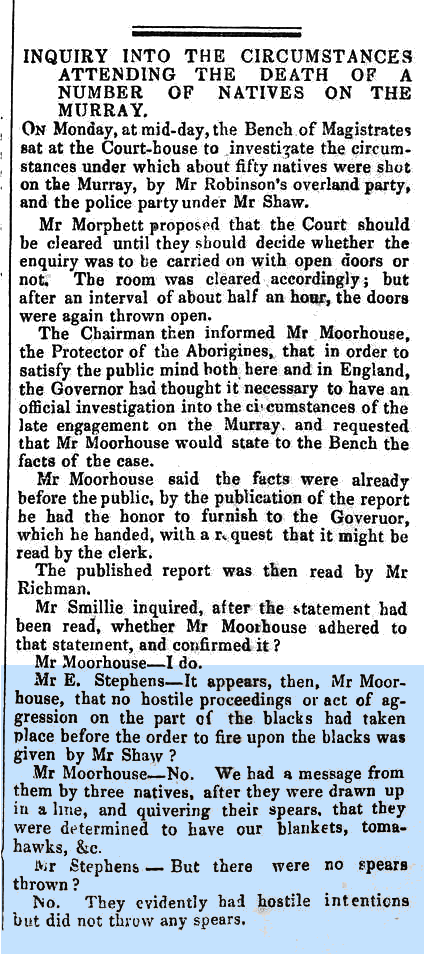
On August 26th, as the party approached the Rufus River, they were attacked by a large number of Aborigines. This attack was repulsed by the overlanders with some 15 natives reported killed. ... The following day, the 27th, the relief party from Adelaide arrived at the 'crossing', where Moorhouse made earnest attempts, via his native interpreters, to placate the situation. But the local natives would have none of it and, while the cattle were being crossed over, the Aborigines attacked in numbers. Again they were repulsed and, again, the natives suffered considerable loss of life, with 20 additional natives reported killed: - The 'Official' death count for the two day confrontation was, therefore, 35 Aboriginals killed. - Nevertheless, it is probable that an indeterminate number of wounded natives did managed to withdraw from the battle zone and, as Aboriginal medicine was ill-equipped to deal with gunshot wounds. It is likely that all, bar the most superficially wounded natives, would have later died from any gunshot wounds they had sustained:
The total aborigines killed during the attacks of 26th and 27th august 1841, is what became known as the "Rufus River Massacre".
There were numerous newspaper articles, official reports, etc., etc., written about this incident at the time. Also an Official Court of Inquiry was convened in Adelaide, to investigate the 'Massacre', and a multitude of witnesses presented a great deal of sworn evidence. -It is all recorded and is retained in the South Australia State Archives. -Brian Glenie has reviewed these old records and has reproduced much of the sworn evidence in his booklet, cited at the head of this page. - It makes very interesting reading. -
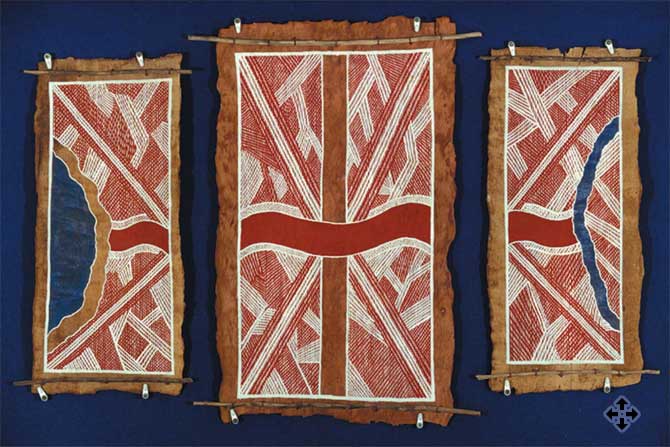
Dennis Claude Thorpe, Rufus River Massacre c. 1998
Synthetic polymer, paint on bark, 3 panels
52 x 23, 36.5 x 62.2, 52.8 x 23.5 cm - Private collection
The Rufus River Massacre
The land is mapped from above, showing the Rufus connecting Lake Victoria and the Murray River. The massacre took place where the brown overlanders' road (from Sydney to Adelaide) crossed the Rufus. It is placed at the centre of the Union Jack, the invaders' flag, depicted by the universally recognised Aboriginal cross-hatching technique, but the red, white and blue colours are decidedly untraditional. The crosses of the road/river junction and the Union Jack form the central panel of the triptych.

Rufus River Massacre Memorial with Lake Victoria in background
MORE
Port Phillip Patriot and Melbourne Advertiser (Vic. : 1839 - 1845) Thursday 14 October 1841 p 2 Trove Newspapers
RELATED:

